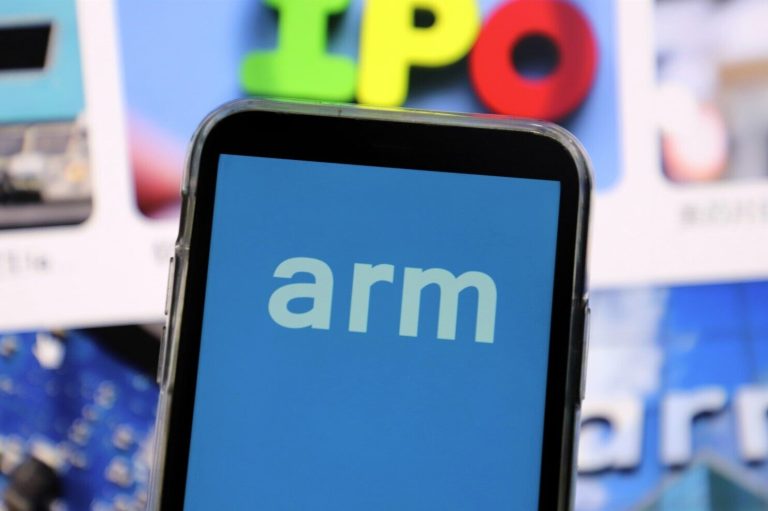The SoftBank-owned chip designer, Arm, has finally come to its debut day after a long waiting period. Investors are eager to see how the UK-based company can ride the AI wave and potentially break a drought in IPO activity that has persisted since 2022. The shares will be available for the public on the Nasdaq Global Select Market under Symbol of “ARM” on Thursday when the US markets open. Most secondary market brokers will have the tickets available on their trading platforms.
The largest IPO of the year
Arm sets its IPO at $51 per share, which is at the highest end of the marketed price range of between $47 and $51. It is set to raise $4.87 billion, marking the largest listing of the year since electric car maker Rivian’s debut in 2021. Earlier, SoftBank planned to raise $8 billion to $10 billion at the IPO, but it decided to buy a 25% stake in its Vision Fund. The company is valued at $54.5 billion at the IPO price, this would mean a price-to-earnings (P/E) ratio of more than 100 times. The success of the IPO will no doubt benefit its conglomerate owner, SoftBank, who took over Arm for $32 billion in 2016. However, SoftBank will maintain 90% of Arm’s stakes, implying that only 10% of the company’s shares are being put on floating. In addition, Intel, Apple, Nvidia, Samsung, and Taiwan Semiconductor Manufacturing are all among its biggest investors.
What makes Arm so popular?
ARM is a chip designer and manufacturer that has been producing processors (CPU) since the 1990s. ARM chips are used in many electronic devices, including smartphones, tablets, laptops, embedded systems, and IoT products. About 99% of smartphone processors use Arm’s technology. In particular, it plays a vital role in electronic device makers such as Apple, Google, and Qualcomm. Unlike a pure chip maker, Arm’s CPU can be seen as an architect that powers communication between software programs and chips by using less power. Arm chips are made by big tech companies, including Amazon, Alphabet, AMD, Intel, Nvidia, Qualcomm, and Samsung. According to a report by Bernstein Research, Amazon makes more than 50% of all Arm server CPUs in its AWS data centres. Also, about 10% of servers globally use Arm processors, and 40% of those are in China, which can be a risky factor amid the recent semiconductor export ban to China by the US.
On the rise of Arm’s popularity in the CPU world, Softbank tried to sell the company to Nvidia for $40 billion in 2020, but the deal failed due to monopoly concerns by the UK government.
Arm’s earnings prospects and AI development
Arm has faced macro headwinds, with its net sales falling 4.6% year on year in the second quarter due to weakened demands in smartphone and PC markets. In its filing to the US SEC, Arm’s revenue was down 1% from a year ago to $2.68 billion, and the net income slipped 22% to $524 million in the fiscal year 2023 from $549 million in the fiscal year 2022.
Arm has asserted its prominence in the AI race by designing processors that will expedite artificial intelligence and machine learning technology. The software designer also aims to develop further functionality to make advanced algorithms programs. According to Bloomberg consensus, Arm’s revenue is expected to be $2.832 billion for the fiscal year 2024, or a 5.6% growth year on year. The earnings per share are forecasted at $0.53 on a net income of $759.5 million, or a 45% jump from the prior year. Arm is financially healthy, with almost JPD¥6 trillion in cash at a low loan-to-value ratio of 8%, which sets it in a good position for buybacks. Nonetheless, the P/E ratio exceeding 100 times may still indicate an overvaluation.
Disclaimer: CMC Markets is an execution-only service provider. The material (whether or not it states any opinions) is for general information purposes only, and does not take into account your personal circumstances or objectives. Nothing in this material is (or should be considered to be) financial, investment or other advice on which reliance should be placed. No opinion given in the material constitutes a recommendation by CMC Markets or the author that any particular investment, security, transaction or investment strategy is suitable for any specific person. The material has not been prepared in accordance with legal requirements designed to promote the independence of investment research. Although we are not specifically prevented from dealing before providing this material, we do not seek to take advantage of the material prior to its dissemination.

